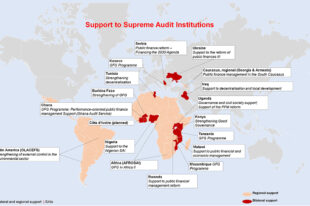Building More Effective Follow-up Audit Mechanisms

Author: National Audit Office of China
I. Introduction
The National Audit Office of China (CNAO) places equal importance on both revealing problems in audit and correcting problems identified. Through in-depth research-based auditing, proactive efforts have been made to heighten the effectiveness of follow-up audit featuring clarified implementation responsibilities, operational workflows, and value added outcomes. Such efforts aim to explore a comprehensive framework for follow-up audit that combines regular correction, themed rectification initiatives, and intensive rectification of major violation cases, which further increased the credibility, efficiency and effectiveness of audit. From 2021 to 2023, the number of corrected audit findings by the auditees increased rapidly, where over 9,700 items of regulation were made or improved, and some 27,000 people were held accountable. Through strengthened efforts for follow-up audits, the CNAO has played an increasingly important role in promoting social and economic development to advance Chinese Modernization. The above-mentioned achievements can be attributed to the following factors:
II. Attaching great importance and requirements to follow-up audit
In 2018, the Central Auditing Commission (CAC), as a coordination and deliberative body, was established with Chinese President Xi Jinping as its head. Chinese Premier Li Qiang and Mr Li Xi, secretary of the Central Commission for Discipline Inspection of the CPC, are deputy heads of the commission. The CAC holds annual meetings to hear audit work reports and provides instructions for audit work including follow-ups. The CAC requires that resolute measures be taken to crack down on corruption as well as address long-standing problems, and that various efforts to do so must foster synergy. Accountability and organizational disciplines must be intensified and more follow-up actions must be taken.
The National People’s Congress (NPC) Standing Committee (SC), as the highest organ of state power of China, deliberates the audit report presented by CNAO in June every year. It sets requirements for follow-up audit and supervises the progress of rectifying outstanding problems identified through audit. Additionally, each year in December, the NPCSC considers a report by the CNAO on progress of rectifications.
As the highest administrative organ, the State Council convenes executive meetings led by the Premier to discuss and coordinate follow-up audits annually in July. Provincial governments and central departments are required to fulfill their rectification responsibilities and, by the end of September each year, report their rectification results to the State Council with copies to the CNAO.
Based on the experience from past practice, in July 2021, the central government issued a circular On Establishing and Improving Long-term Mechanisms for Rectifying Problems Identified in Audit Reports, which served as a fundamental institutional framework for strengthening follow-up audit.
III. Enhancing the quality of audit recommendations
Follow-up audit has placed yet higher demands on the quality of audits. In practice, CNAO continues to optimize audit methodologies, and incorporate a research-based approach throughout the entire audit process at each and every stage. In looking at the audit approach as a basic precondition, the selection and implementation of projects flows from the big picture to policies, then to projects, and ends in funds. If taking the audit approach as a basic methodology, the analysis and recommendations flows from funds to projects, then to policies and ends in the big picture. This is like a consistent thread which can be taken top-down and bottom-up in both directions.
Throughout this process, CNAO remains focused on two key aspects. First, the research ultimately aims to serve audit practice. Second, the direction of research-based auditing must be in alignment with the big picture, strategic plans and policy requirements of the central government regarding the sectors, regions and industries to be audited, as well as the historical, development, and business context of the auditees. Research-based auditing ensures that audit results are based on facts and data with solid evidence, and audit recommendations are well-grounded, thoughtful, and insightful.
This approach enables auditors to provide quality and practical recommendations with the big-picture view, serving as a reliable basis and an important reference for the decision-making of the central government.
IV. Improving the accountability system for follow-up audit
CNAO has made significant efforts to establish a comprehensive follow-up audit system of accountability that includes various stakeholders across the board. This system encompasses three main aspects:
First, responsibilities of audited entities for rectification. The leaders of audited entities are primarily responsible for addressing the problems identified in the audit. They prioritize rectification of audit findings by incorporating this action into the agenda of leadership meetings and see to it that rectifications happen in an authentic, complete and compliant manner.
Second, supervisory responsibilities of competent authorities. The audit institution reports the identified problems to competent authorities, who are responsible for supervising the rectification process, ensuring that audited entities implement the necessary changes. Institutional mechanisms are reformed to address the root causes of common and emerging problems.
Third, urging and monitoring responsibilities of audit institutions. Recommendations provided by an audit institution after audit fall into three categories: those concerning matters that require (1) immediate, (2) phased or (3) continuous rectification. Audit institutions may carry out special audit investigations to verify whether rectifications happen and all the reported matters are rectified, in order to reach conclusions about the rectification results.
V. Building a comprehensive framework for follow-up audit and impact
Past experience has proven that the final resolution of many audit findings relies on the joint efforts of various stakeholders. A single entity alone cannot achieve this. Synergy formed through strengthened collaboration of all is an effective way to ensure that audit recommendations are followed.
Over the years, the CNAO has strengthened collaboration with the National Supervisory Commission (NSC), the NPC, stakeholders, and other supervisory bodies to build a comprehensive framework for follow-up audit that combines regular correction, themed rectification initiatives, and intensive rectification of major violation cases. The framework emphasizes both overall coverage and targeted rectification actions, with a particular focus on addressing prominent problems.
For regular correction, the CNAO has, based on a list of over 30,000 problems identified in audits over the past years, distributed rectification notifications to relevant local authorities and departments, and required audited entities to fulfill their responsibilities for rectification. The audited entities must report their results of regular correction to the CNAO by the end of September each year.
For themed rectification initiatives, relevant departments, in collaboration with the audit institutions, conduct inspections and supervise rectifications under different themes. A few examples include:
- The General Office of the State Council has conducted special inspections to understand the rectification progress, with a focus on problems such as inadequate, non-compliant, or delayed rectifications.
- The Budget Committee of the NPCSC supervised the rectification of outstanding problems related to local government debt, transfer payments, state-owned assets, and other areas, and produced reports which were deliberated by the NPCSC.
- The CNAO conducted special audit investigations to examine the rectification results of over 2,170 problems reported in the past three years, and identified some common issues such ineffective, false, and perfunctory rectifications. The CNAO produced the audit investigation report and urged the audited entities to take further rectification actions. Most of the identified problems have now been resolved. As for intensive rectification of major violation cases, the CNAO has transferred more than 100 significant problems to disciplinary inspection commissions, finance departments, tax authorities, and other relevant departments for further investigation and accountability over the past two years, and has received feedback reports provided by competent authorities on the progress or results of rectifications. More than 68 billion Yuan (8.7 billion Euros) has been recovered or saved through assets recovery and cost reduction measures, while relevant persons have been held accountable.
VI. Conclusion and Looking Forward
Besides the achievements made in China’s efforts and commitment to follow-up audit, explorations for effectiveness never stops. In the next step, the CNAO, on the basis of experience gained, will make new efforts to further optimize the follow-up audit system, and facilitate the collaboration between audit and other forms of oversight, so as to put follow-up audit into real effects and efficiency of governance.





